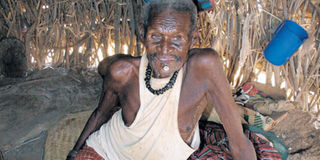Kenya to host hunger meeting

JARED NYATAYA | NATION
Mzee Aiyanai Kitoi inside his manyatta at Lopois Village in Turkana East District on Thursday. The elderly man is among 3.5 million Kenyans facing starvation due to persistent drought.
The government has called an international conference on the famine ravaging the Horn of Africa region.
The military and the National Youth Service have also been called in to help in the distribution of relief food to more than 80 per cent of the country experiencing drought.
They were among the drastic steps that the Cabinet agreed on Thursday to tackle the worst food crisis in decades to hit Kenya and neighbouring states of Ethiopia, Somalia and Djibouti.
“The Cabinet agreed that Kenya will host an international conference to address the drought and food crises in the horn of Africa.
The dates of the meeting will be agreed upon with regional and international partners,” a dispatch from the Presidential Press Services said.
It is the second time in two weeks that a Cabinet meeting chaired by President Kibaki has pre-occupied itself with a crisis that has placed more than 3.5 million Kenyans at risk.
Two weeks ago, the Cabinet allocated Sh9 billion — Sh5 billion from the Consolidated Fund and Sh4 billion to be raised through budgetary cuts—to fight hunger and drought that has ravaged North Eastern, Coast, Eastern and parts of the Rift Valley.
So far, Treasury has released Sh8 billion to buy relief food.
The food shortage has been complicated further by the influx of starving refugees from Somalia overunning the Dadaab refugee camps in Garissa County. Kenya has been under sustained pressure form the UN to open the another camp to take in more refugees.
The Cabinet meeting yesterday resolved to invite both regional leaders and the wider international community to help save millions of people in the Horn of Africa.
“The conference will seek emergency food requirements for the 14 million people requiring food relief in the Horn of Africa. The meeting will also support the opening of feeding camps inside Somalia in order to stop the influx of refugees to neighbouring countries especially Kenya. ” said the PPS.
The Dadaab camp which was built to host 90,000 refugees now accommodates more than 400,000, with about 15,000 new arrivals each month.
Apart from seeking immediate measures to avert disaster, the meeting will come up with both medium and long term solutions to the yearly rituals of drought and food shortages in the region.
The leaders will also tackle the social and security issues such as lack of a stable government in Somalia which have contributed to the worst food crises the region has faced in a long time.
To tackle the local food emergency, the cabinet directed more efficient distribution of relief food.
The National Cereals and Produce Board (NCPB) will buy maize that is being imported and the fresh harvest from South Rift to be distributed.
The worst hit areas are parts of North Rift, Eastern and North Eastern provinces.
On Wednesday Prime Minister Raila Odinga told Parliament noted that more relief efforts were needed as the drought was spreading fast across the country.
Several areas in Eastern, Rift Valley and North Eastern that in May were in the crisis phase have since been upgraded to emergency phase requiring urgent interventions.
Initially, 3.5 people were affected by the drought, but the number has risen to four million people, with parts of Nyanza, Western and Central also hit, Mr Odinga told Parliament.
“The areas considered to be in crisis have widened steadily, from March, to May, and to July this year,” he said.
The vulnerable population are concentrated in the counties of Wajir, Kitui, Turkana, Makueni, Garissa, Kwale, Mandera, Marsabit, Kilifi, Samburu and Kajiado.




